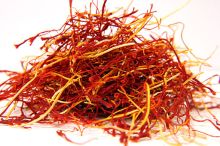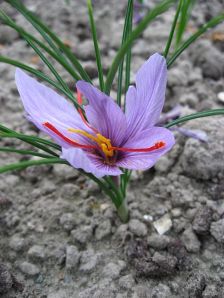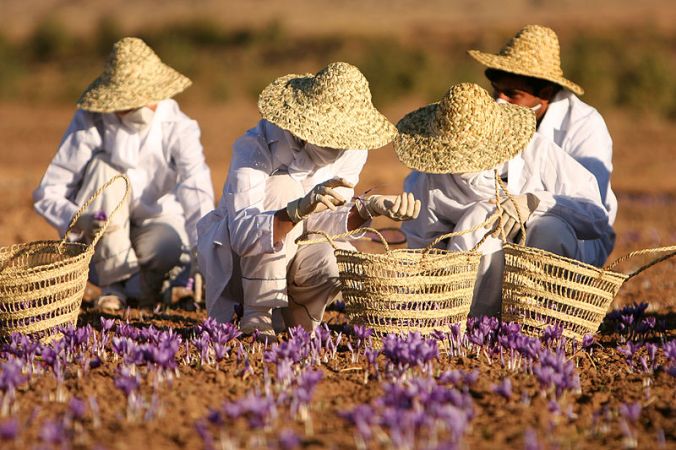
Saffron is made by drying stigmas from Crocus sativus flowers. Image by Safa Daneshvar (CC-BY-SA-3.0) via Wikimedia Commons
Saffron is the world’s most expensive spice by weight. Its vibrant orange-red colour means that as well as being used for flavouring food, it can also be used to dye fabric. Saffron comes from the stigmas (female part) of Crocus sativus flowers. Each stigma is hand-picked, dried and then sold whole or as saffron powder. Since each flower only contains 3 stigmas, around 150,000 flowers are needed to make 1 kg of saffron (1).
C. sativus is an autumn-flowering perennial. It has been cultivated for over 3000 years and today is grown across the world in countries including Spain, Iran, Afganistan, India, Tibet and China (2). Spain and Iran are the biggest producers accounting for over 80% of production (2). The species does not exist in the wild, and is thought to be descended from the Mediterranean autumn-flowering crocus C. cartwrightionus (2).
C. sativus is triploid, meaning that its genome has three copies of each chromosome instead of the more typical two (diploid organisms like us humans). This makes C. sativus infertile because its chromosomes don’t pair up properly during meiosis (cell divisions that produce sperm and egg cells for sexual reproduction). In the absence of sexual reproduction, C. sativus is propagated vegetatively, by digging up and separating the corms (bulb-like storage organs) before replanting.
The vibrant orange-red colour of saffron is due to the presence of carotenoid compounds, primariliy crocin (4). The bitter taste is due to picrocrocin, a breakdown product of the carotenoid zeathanin (3). When C. sativus stigmas are dried, some of the picrocrocin is converted to safranal, which is largely responsible for the “hay-like” aroma of saffron (3). Historically, C. sativus was highly valued as a medicinal plant, and evidence is emerging that some of the compounds in saffron may have medicinal properties, including as antioxidants, cancer treatments or anti-depressants.
References:
1) Laws (2010) Fifty plants that changed the course of history. David and Charles.
2) Rubio-Moraga (2009). Saffron is a monomorphic species as revealed by RAPD, ISSR and microsatellite analyses. BMC Res Notes.
3) Wikipedia: Saffron. http://en.wikipedia.org/wiki/Saffron (retrieved 16/04/14)
4) Wikipedia: Crocin. http://en.wikipedia.org/wiki/Crocin (retrieved 16/04/14)


Wow, I knew saffron was fiddly, but didn’t realise the plants only produced 3 stamens per flower! That’s crazy! It is such a fantastic flavour though. One of the most important Cornish foods (after pasties and clotted cream, of course) is saffron cake, a yeasty loaf or bun. Mmmm! 🙂
Yeah I didn’t realise how little saffron came from each flower before either – explains why its always been such an expensive spice! Mmm, a saffron cake sounds tasty, dont see them around much where I live, might have to try baking some. 🙂
Saffron is pretty neat, and I appreciate hearing more about the biochemical nature of its flavors. I can’t help but wonder whether plan geneticists could boost the yields and make harvesting easier. Since the saffron flower is already for the most part sterile and the most valuable part of the plant is the stamen, then let’s turn the other flower parts into stamens! While breeding would be difficult on account of the sterility, perhaps targeted mutagenesis or a transgenic approach could alter the expression of floral homeotic genes to convert the other organs into stamens. Instead of 3 stamens, you could have 12 if you converted them all! And with no petals to pick them out of, it could make harvesting easier.
Just a thought.
Interesting idea. It might be possible but I dont know if anyone has tried to transform Crocus sativus or how extensively the genetics have been studied.
Pingback: Nibbles: Rural income sources, Medicinal trees, Saffron, Biofuel trees, Trout genome, Maize & drugs in Mexico, Bee-keeping, Urban ag, Food security | Gaia Gazette
Pingback: Morsels For The Mind – 25/04/2014 › Six Incredible Things Before Breakfast
Pingback: April Berry Go Round: Plant Colors | New Under The Sun Blog
Pingback: Medical researchers make important research link between active ingredient in saffron and MS / ancient virus in our DNA « Health Research Report
Pingback: Your Interesting Links | Zen Mischief
Saffron spice may well be one of the most expensive spices around, but my goodness is it worth the price!
Pingback: Saffron | euzicasa
Pingback: The precious pods of the vanilla orchid | Plant Scientist